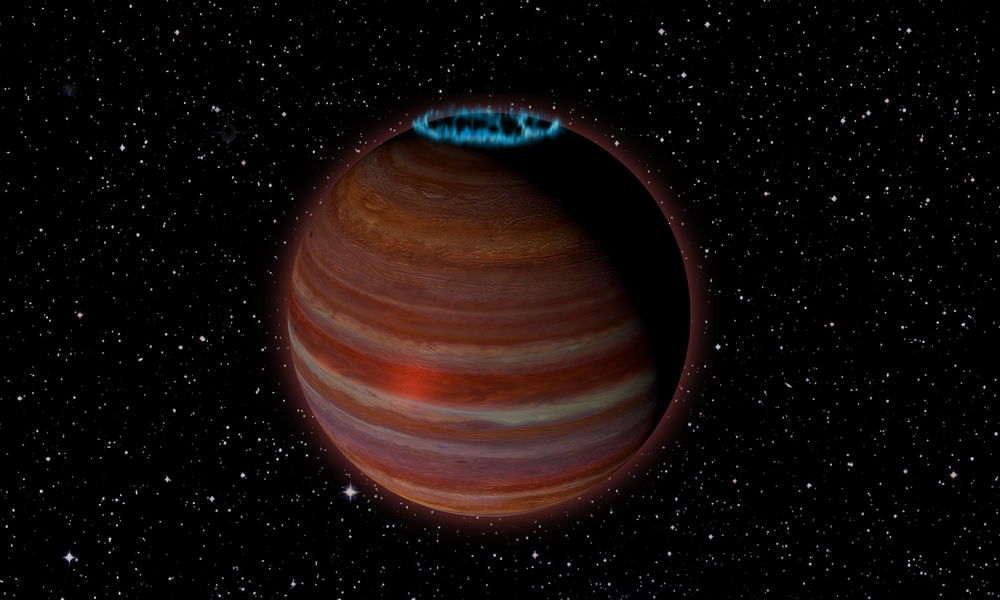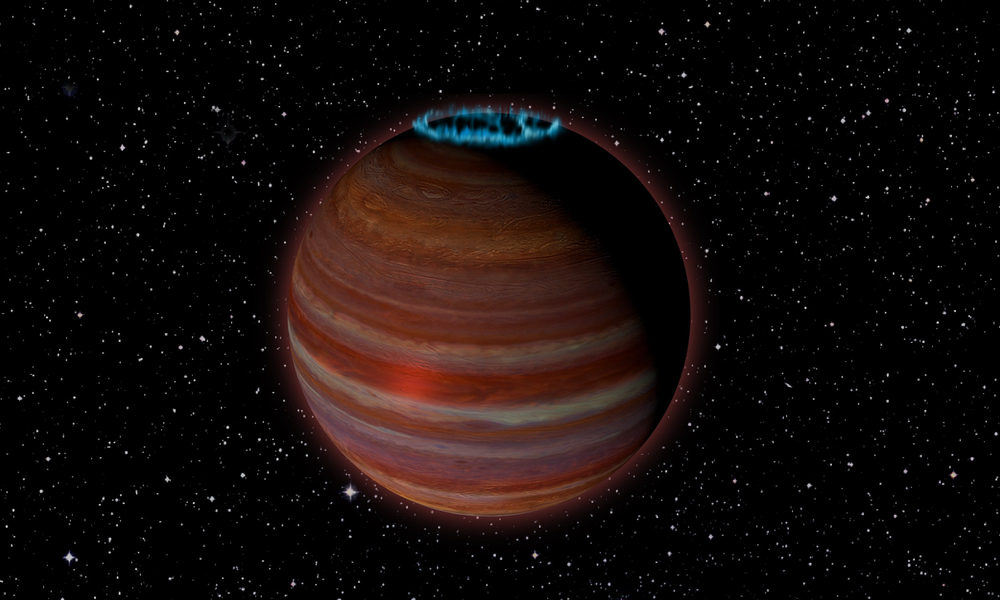An Isolated Exoplanet Has a Patchy Atmosphere
The astrophysical object SIMP0136 is an oddity. With a mass just below that of 13 Jupiters, it fails to meet the criteria for a brown dwarf, where conditions in the star’s interior are intense enough to sustain the fusion of deuterium. It also fails to meet the prime criterion for an exoplanet, as SIMP0136 does not orbit a star. The absence of a star and the lack of its bright light have, however, made SIMP0136 amenable to observation since its discovery in 2006. Now Allison McCarthy of Boston University and her collaborators report the most sensitive spectroscopic study of the object so far [1]. Using the JWST, the researchers monitored SIMP0136 in 2023 for 6 hours, which corresponds to 2.5 rotation periods of the object. The variations in the object’s infrared spectrum confirmed previous inferences of the presence of patchy clouds. They also contained surprises: evidence of hot spots in the upper atmosphere and fluctuating carbon chemistry.
Ground-based observations of SIMP0136 in 2016 revealed that its infrared emission varies over each rotation period and on timescales of a few days or more. Because the JWST observed the object for just 2.5 rotation periods, the variations it recorded were likely mostly caused by spatial inhomogeneities coming into and out of view as SIMP0136 turned on its axis. Team-lead Johanna Vos of Trinity College Dublin decided to split the observing time in two, spending the first half with one instrument, NIRSpec, which covers the wavelength range 0.6–5.3 µm, and the second half with MIRI, which covers 5–14 µm. Both instruments were operated in modes that yielded hundreds of light curves, each a few tenths of a micrometer wide.
When the researchers analyzed their data, they found variations in flux at all wavelengths. What’s more, the flux variations themselves depended on the wavelength. For example, when the emission at 2.6–3.0 µm was higher than the average, the emission at 1.5–1.8 µm was lower than the average.
Running a clustering algorithm on the individual light curves recasts distinct behavior into nine groups. McCarthy and her collaborators compared those nine bands with those predicted by a model developed to characterize the spectral variability of the atmospheres of the coolest brown dwarfs [2, 3]. These objects have so little deuterium to begin with that, even if they haven’t exhausted their supplies, they resemble objects below the 13-Jupiter-mass threshold, to the point that temperature is the principal variable. Their atmospheres are so cool that iron, magnesium, silicon, and other elements react with oxygen and condense into patchy clouds. Four of the clustered groups probed pressures—or, equivalently, depths—at or below where the patchy silicate clouds exist, suggesting that their variability was likely caused by the inhomogeneities in the silicate cloud layer. The five other clusters probed pressures found above the silicate cloud layer. McCarthy and her collaborators therefore sought another driver of variability. Comparison with model spectra pointed to the presence of a zone of higher-than-average temperature—a hot spot—which could correspond to an aurora or a convection cell.
Although the model’s combination of clouds and a hot spot accounted for most of the variation as a function of wavelength, it failed around 4.5 µm, where the variation in the observations was greater than predicted. At those wavelengths vibrational modes of carbon monoxide and carbon dioxide are the strongest contributors to the spectrum. Spatial fluctuations in the abundances of the two species could arise if localized storm regions and eddies are present.
“The unique thing about this [study] is the wide wavelength coverage provided by [the] JWST, enabling in-depth characterization and unparalleled time resolution,” says Elspeth Lee, who studies the atmospheric climates of exoplanets and brown dwarfs at the University of Bern in Switzerland. “This [result] lines up with 3D simulations of these planets that suggest the formation of storm and jet structures that go on to affect the day-to-day variations found in the atmosphere.”
Although SIMP0136 is not in orbit around a star, it might once have been, qualifying it as a so-called rogue planet. Regardless of the status of SIMP0136, McCarthy points out that gas giants can have complex, fast-changing weather. “Understanding how these atmospheres behave helps us learn more about exoplanets including those that might be more like Earth,” she says.
–Charles Day
Charles Day is a Senior Editor for Physics Magazine.
References
- A. M. McCarthy et al., “The JWST weather report from the isolated exoplanet analog SIMP 0136+0933: Pressure-dependent variability driven by multiple mechanisms,” Astrophys. J., Lett. 981, L22 (2025).
- C. V. Morley et al., “Spectral variability from the patchy atmospheres of T and Y dwarfs,” Astrophys. J., Lett. 789, L14 (2014).
- C. V. Morley et al., “The Sonora substellar atmosphere models. III. Diamondback: atmospheric properties, spectra, and evolution for warm cloudy substellar objects,” Astrophys. J. 975, 59 (2024).





